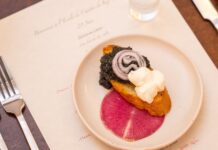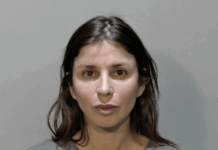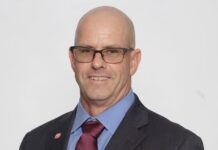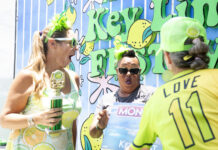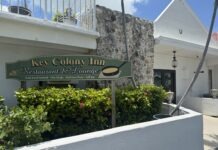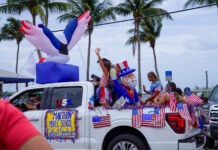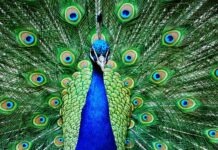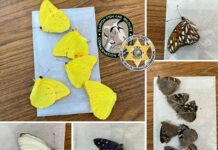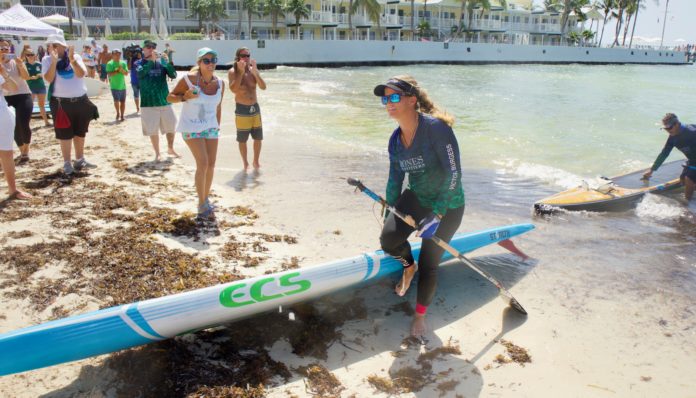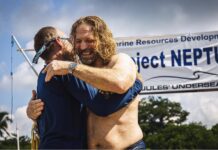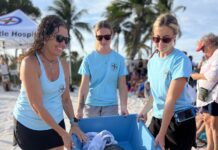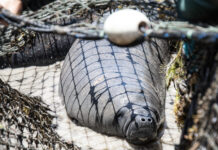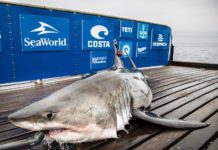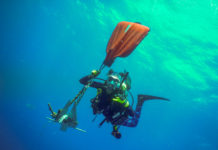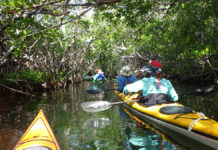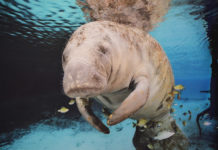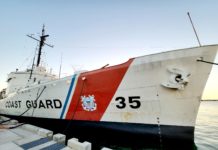Paddleboarder Victoria Burgess made the trip from Cuba to Key West in under 30 hours this past week and, in the process, become a Guinness Book of World Records winner. There are 267 SUP (Stand Up Paddle) records, but Burgess is the first woman to make the crossing between the islands on a stand-up board.
Burgess started paddling competitively about four and a half years ago. She’s won a bunch of races including placing sixth in the 2016 world championships — a 33-mile crossing from the island of Molokai to Oahu under challenging conditions that included 10-foot seas.
“I used to surf when I was in my 20s,” said Burgess, 32. “I gravitated toward ocean paddling because I don’t like flat water.”
She undertook the endurance crossing she said, as a way of staying in the game even if she’s not racing fulltime. She said she likes the navigational aspect of it. (Plus, it’s hard to compete with the athletes who train and race for a living, unlike Burgess, who is a full-time employee of the Pompano Beach Fire Department.)
The Keys Weekly gave her a couple of days to recover from her June 26-27 endeavor, and then we grilled Burgess, 34, like a cheese sandwich. We. Had. So. Many. Questions.
Keys Weekly: Quick bio, please.
Victoria Burgess: Born in New York, moved to Florida at age 5. Grew up in and around Broward County. I was a firefighter and paramedic, but now I am a fire inspector — it’s more of a 9 to 5 job; I like the regular schedule.
KW: Can you tell us about the trip over to Cuba, and your crew?
VB: Capt. Bob Olin and the Sunluver Charters of Key West, plus another captain named Chris. My personal support crew included my boyfriend Rory, a friend Jake who is also a paramedic, a friend Bon who is also a retired Marine and lifeguard, and a videographer, Erin Dean. We left Key West on Sunday evening and got there Monday afternoon. We had enough time to check in, do a couple hours of sight-seeing, and I left from the Hemingway International Yacht Club at 7:15 a.m. on June 26.
KW: What type of board?
VB: I used one of my sponsor’s boards. The ECS is based out of Australia. This particular board is a stock model with a pointy nose, more volume, and light; it’s made out of carbon fiber.
KW: Did you wear shoes?
VB: I had some five-finger toe shoes ready in case there were jellyfish, but I didn’t need them.
KW: Exactly how long did it take?
VB: 27 hours and 48 minutes.
KW: Did you see anything on the crossing?
VB: Not really. There were more wind and seas — about 2 to 4 feet — than predicted, so I couldn’t really look around. I had to paddle on my left side about 90 percent of the time. And there was a squall at some point and the weather kicked up for about two hours.
KW: Did you nap?
VB: No. I tweaked my right knee bracing myself against the waves so I had to sort of hop down and sit on the board with my feet in the water to eat and rest. But, because of my job, I’ve been able to function 1,000 percent on very little sleep for years.
KW: What did you eat?
VB: I ate every hour and snacked every half hour. My meals were peanut butter and jelly sandwiches, chicken burritos and pasta Alfredo. Snacks were sugary stuff like Oreos and bananas. I drank water with a supplement of caffeine and carbs. I think I consumed about 10,000 calories in the crossing, but I didn’t cramp or run out of energy.
KW: Did you listen to music?
VB: Well, my GPS tracker and earphones fell in the water about two and a half hours out. It just plunked, and it was gone. (That’s when her GPS tracking website stalled.) I thought, “My parents are going to kill me.” But I had a Bluetooth speaker I could hear from the boat and we played music. But I didn’t get to listen to all the podcasts I had downloaded.
KW: Your longest training run was 12 hours, and this crossing took you almost 30 hours. What do you tell yourself about that gap as you’re paddling?
VB: It’s all mental and I did that training — yoga and relaxation. I get in a zone. I did have a struggle about an hour after it got dark, but I made myself keep going. I kept telling myself, “This is what you’ve been practicing for.” And having the right nutrition helped, too.
KW: What other training?
VB: Well, I’m a sports nutritionist so I paid attention to that. I also do weight training, run, crossfit and yoga. I worked out on my lunch break, and paddled after work, building up to the long runs on the weekend.
KW: You branded this crossing as Chica Libre; can you tell us about that?
VB: It means “free girl.” I work with lots of women and train women. I know it’s hard — there are days I would rather eat lunch than go work out. My grandmother died in January. My dog died a month and a half ago. It’s hard to train. We all go through challenges and we tend to make excuses that hold us back for one reason or another. I wanted to show that no matter what you’re doing, you don’t have to do that. You can free yourself from holding back. You can free yourself from the negative stuff.
